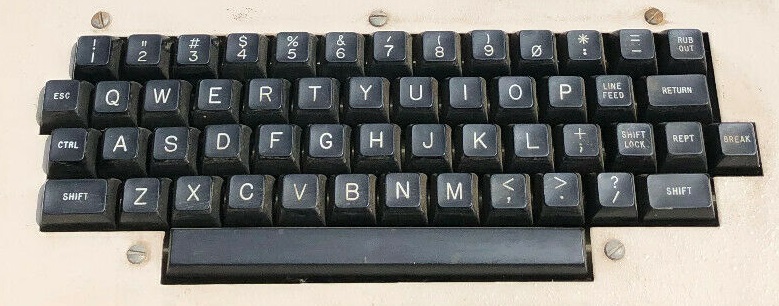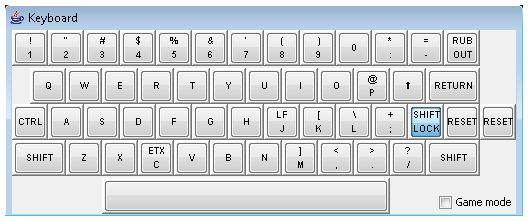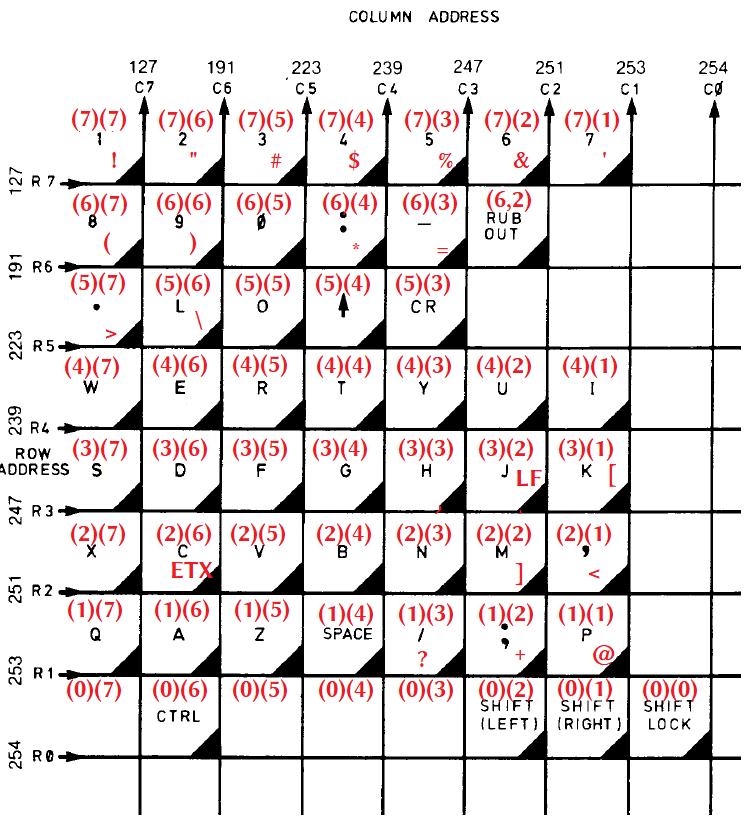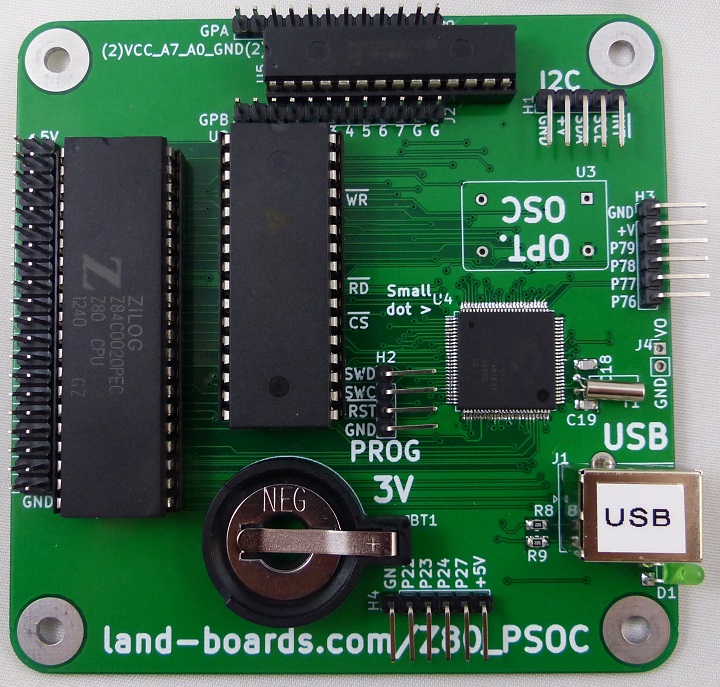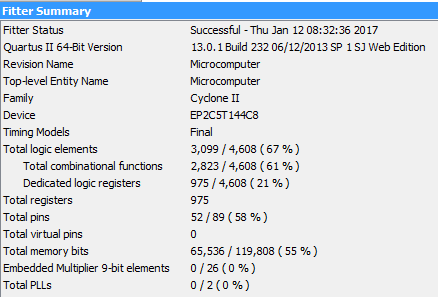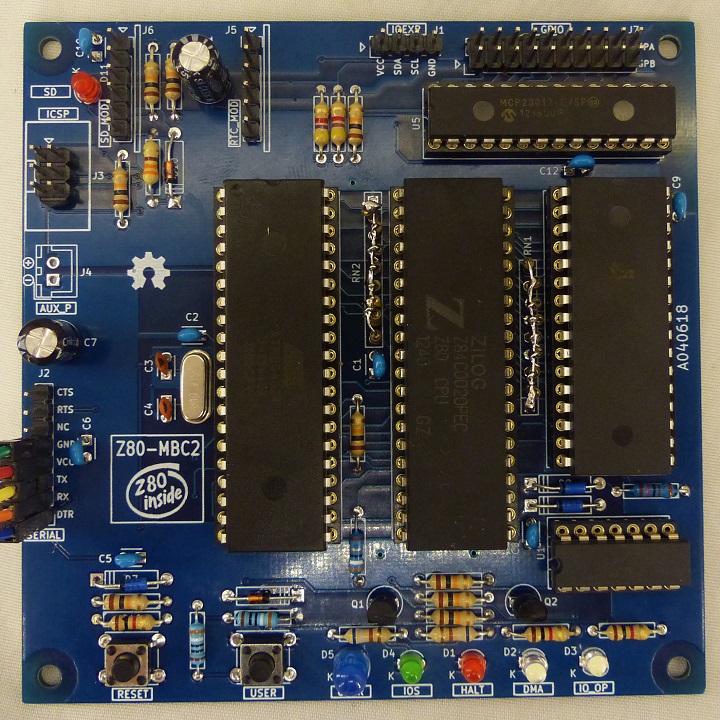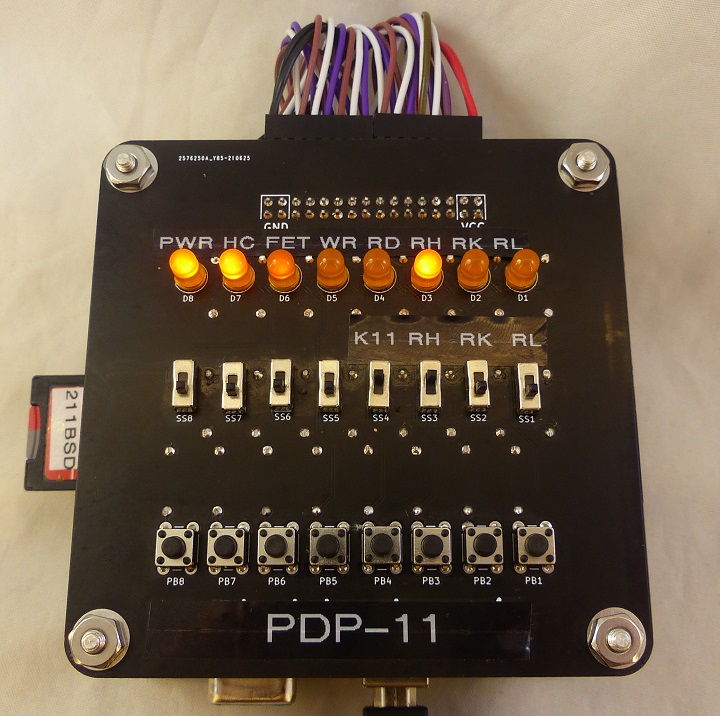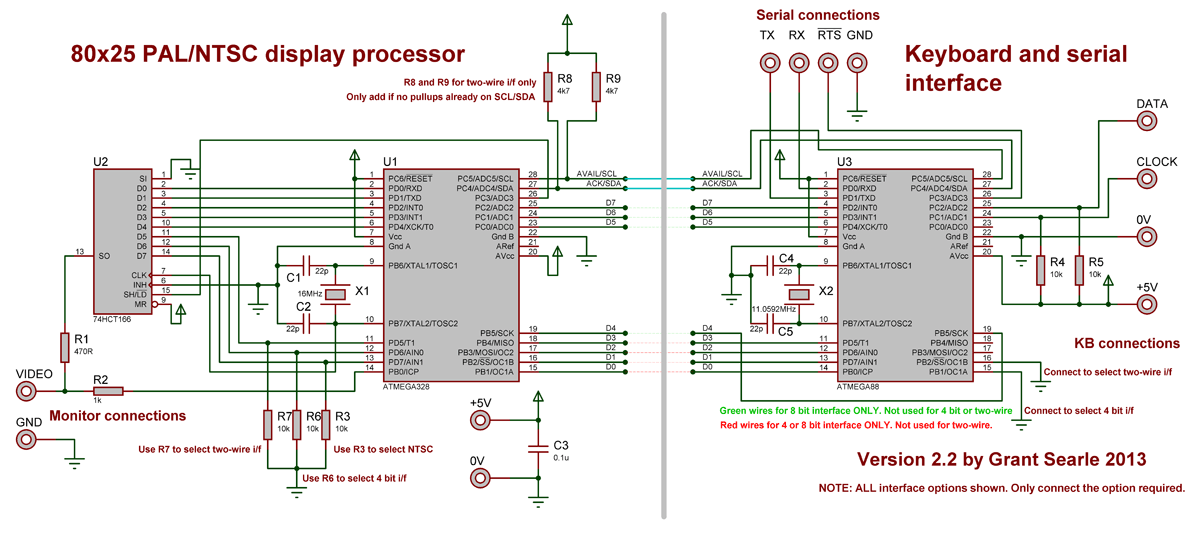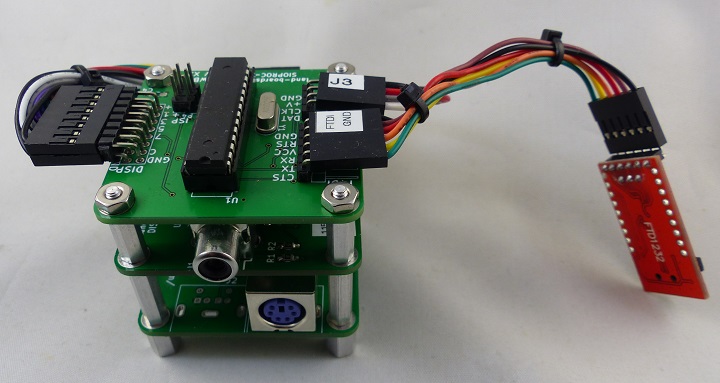Difference between revisions of "RetroComputers"
Blwikiadmin (talk | contribs) |
Blwikiadmin (talk | contribs) |
||
| Line 659: | Line 659: | ||
* Builds of two platforms | * Builds of two platforms | ||
** [https://github.com/douggilliland/Retro-Computers/tree/master/68000/TG68_AMR AMR] - CPU with VGA frame buffer from SDRAM and other peripherals | ** [https://github.com/douggilliland/Retro-Computers/tree/master/68000/TG68_AMR AMR] - CPU with VGA frame buffer from SDRAM and other peripherals | ||
| − | ** [https://github.com/douggilliland/Retro-Computers/tree/master/68000/TS2_FPGA TS2] - Basic 68K CPU with character display | + | ** [https://github.com/douggilliland/Retro-Computers/tree/master/68000/TS2_FPGA TS2] - Basic 68K CPU with VGA character display |
=== TG68_AMR Design === | === TG68_AMR Design === | ||
Revision as of 14:47, 19 June 2024
Contents
- 1 Grant Searle's FPGA MultiComp Project
- 2 6800 CPU
- 3 6502 CPU
- 4 6809 CPU
- 5 Z80 CPU
- 6 68000 CPU
- 6.1 TG68_AMR Design
- 6.2 TeeSide 2 design with Multicomp parts
- 6.2.1 TeeSide 2 Memory Map
- 6.2.2 TeeSide 2 Monitor ROMs
- 6.2.3 TeeSide 2 Build on RETRO-EP4CE15 Running TS2 Monitor
- 6.2.4 TeeSide 2 Build on RETRO-EP4CE15 Running TUTOR Monitor
- 6.2.5 TeeSide 2 Build on Cyclone V Running TS2 Monitor
- 6.2.6 TeeSide 2 Build on Cyclone V in Box Running TS2 Monitor
- 6.2.7 TeeSide 2 Software
- 6.2.8 TeeSide 2 Links
- 6.3 68000 Software
- 6.4 Other People's 68000 Builds
- 7 DEC (Digital Equipment Corp) Computers
- 8 RISC V CPU
- 9 Terminal
- 10 External Sites
Grant Searle's FPGA MultiComp Project
FPGA Recreations of 6502, 6809, and Z80 Vintage Computers
- Multicomp on Land Boards Cards - Hardware
- Multicomp on Purchased Cards
- FPGA Support Cards
- MultiComp Wiki Page on GitHub
- Multicomp Github repo
Our MultiComp Retro-Computer Video Series
Cyclone II Video Series
Cyclone IV Video Series
6800 CPU
My First Computer Build
My first attempt to build a computer was way back in 1977 (before my Ohio Scientific SuperBoard II). The homebrewed computer based on an MC6800 CPU so the CPU has a soft spot in my heart. I never took any pictures of it and the hardware is long gone now. These are the pieces of it I remember.
- Elco? 120 pin edge connector wire wrapped cards with homebrew backplane
- 6800 Processor board running at 1 MHz
- 2K of Static RAM board
- 2716 EEPROM board (may have had 4 sockets total, don't recall for sure)
- Front panel switches and LEDs to enter the address/data and blink lights
I remember getting it to run and I do remember blinking a light back and forth on it. Once I got the SuperBoard II, I stopped working on my own board. I didn't have an assembler so I have assembled code to machine code.
It might be fun to reproduce that board!
6800 SmithBug Builds
This MultiComp build fills a hole in Grant Searle's Multicomp (he hadn't finished a 6800 version).
It also completes the project I started back in 1977 with a lot of built-in features I could never have imagined back in the day.
- MC6800 CPU
- SmithBug ROM supports up to 60KB of SRAM
- 25 MHz
- SRAM size options to match FPGA capacities
- 4KB SRAM (for small FPGAs)
- 32KB (Internal) SRAM version (requires EP4CE15 minimum)
- 60K (external) RAM version
- 60K RAM version (requires Cyclone V FPGA)
- MC6850 ACIA UART
- Video Display Unit (VDU)
- Color attributes
- XGA 80x25 ANSI character display
- Extended (256) character set
- PS/2 keyboard
- Runs Tom Pittman's Tiny BASIC
- Build on EP4CE15 card
- Build on EP2C5 card
- Build on EP4CE10 card
- Build on EP4CE6 card
- Build on EP4CE15 Starter Kit card
- Build on EP4CE6 card (RETRO-EP4)
- Build on EP4CE6 card (RETRO-EP4) 60KB SRAM
- Build on EP4CE15 card
- Build on EP4CE15 card 60KB SRAM, 1MB Banked SRAM
- Build on EP4CE15 card Front Panel control
- Build on Cyclone V card 60KB SRAM, 1MB Banked SRAM
Memory Map (60KB SRAM version)
- $0000-$EFFF - Up to 60KB external SRAM
- $0000-$EEFF - User RAM area
- $EF00-$EFFF - Scratchpad RAM used by MIKBUG
- $0000-$EEFF - User RAM area
- I/O Map
- $FC18-$FC19 - VDU
- $FC28-$FC29 - ACIA
- J3 right side position - PIN_B22 (EP4CE15) of the FPGA swaps addresses of VDU and ACIA port
- Installed (PIN_B22 to Ground) uses ACIA Serial port
- Removed uses VDU
- $F000-$FFFF - SmithBUG ROM
- I/O "hole" opened up at 0xFC00-0xFCFF
6800 with Front Panel Running SmithBug
- Adding a modern version of a Front Panel completes the build of my 1977 6800 Computer
- Hackaday Front Panel page
6800 FIG-Forth Builds
- Build on RETRO-EP4CE15 FPGA - Runs out of ROM with Front Panel and boots directly to FigForth
- Build on RETRO-EP4CE15 FPGA - Runs under SmithBUG with Front Panel build - Run via J 0100
- 6800 FIG-Forth Builds - Wiki page
6800 FIG-Forth Reference
- 6502.org Forth Forum
- Forth Interest Group
- Silicon Valley Forth Interest Group
- Kim Harris' Forth Course
- MIKBUG on MultiComp - Hackaday page
- FigForth Wiki page
- FigForth FPGA files
- FigForth Software Build
- Starting Forth book - Brodie
- Thinking Forth by Leo Brodie
- The Evolution of Forth - History and internals of Forth
- Journal of Forth Application and Research
- FIG-FORTH internals
SWTPC
- Memory map (Hexadecimal Addresses):
- 0000-7FFF: RAM
- 8004-8007: MC6850 ACIA (UART)
- A000-DFFF: RAM
- E000-FFFF: SWTBUG Monitor ROM (visible on every 1 k memory location)
- Emulated components:
- Motorola MC6800 CPU (SWTPC mp-a)
- Motorola MC6850 UART (SWTPC mp-s)
- 48k RAM
6800 Software Development Tools
- 6800 Software Development Tools - GitHub Wiki page
- DREAM 6800 Archive Site - CHIP-8 Software
6502 CPU
- Several builds
- My original Ohio Scientific SuperBoard II
- MultiComp build of Ohio Scientific SuperBoard II
- OSI 6502 Build
Ohio Scientific SuperBoard II
This was my first commercial personal computer.
- Manufacturer: Ohio Scientific
- Model 600 Rev B Board Manual
- Model: SuperBoard II ( Model 600 )
- Available: 1978
- Price: US $279 assembled
- CPU: 6502
- RAM: 4K static RAM, 8K max
- CEGMON - Monitor in 4K of EPROM
- Display: composite video, 30 X 30 text
- Built-in keyboard
- Single board design
- I eventually got a Model 610 24KB RAM expansion card with Floppy Disk Controller
- Ports: composite video, cassette
- Storage: cassette
- Microsoft BASIC
- 2K Monitor ROM (CEGMON)
- Compkit 101 - British clone of the SuperBoard II
SuperBoard II Emulator
- OSI Challenger 1P (8Kb) with Debugger - JAVA web based emulator
- OSI Challenger 1P (32Kb) with Disk Support - JAVA web based emulator
- pill_6502: 8-bit 6502 CPU and 6850 ACIA emulation on the STM32 blue pill to run Microsoft BASIC from 1977
Keyboard Layout
- PS/2 Keycodes
- Keyboard matrix
SuperBoard II/ Retro-Tech Refresh
I was looking around for a way to recreate my OSI Superboard and found Grant Searle's design.
- EP2C5-DB - Our creation of a daughtercard which implements Grant Searle's Multi-Computer
- Grant Searle's CompuKit UK101
- Based on Cyclone II EP2C5 Mini Dev Board
- Someone built one of the CompuKit clones as a CPM box
Superboard II Documents
- Dave's OSI Repository - Lots of scanned documents up there - large file sizes
- Compukit UK101 Docs on Sourceforge]
- CEGMON – a blast from the past
- Code for the 6502 microprocessor, mostly for the Replica 1 computer
- Nice page on the C1P/Superboard II
- 6502 Instruction Set
- Compukit 101 video
- Ohio Scientific publications
- Enhanced 6502 BASIC
- Experience porting Enhanced Basic to a 6502 Computer
- "EhBASIC is about 11 KB"
- Experience porting Enhanced Basic to a 6502 Computer
- 6502.org - the place for retro 6502 projects
- System68
- L-Star: Software-Defined 6502 Computer - Uses a Propeller chip
- Pick-and-mix to create your own custom computer on a low-cost FPGA board
- Daryl's Computer Page
- Daryl has designed multiple single board computers
- 6502 Assembly Language books - archive.org
- Micro 6502 Journal
- DABUG Monitor ROM
MultiComp 6502 Builds
- Two Builds
- OSI C1P/SuperBoard II/UK10
- OSI 6502
OSI C1P/SuperBoard II/UK101 Builds
- Build on RETRO-EP4CE15 card
- Build on ESTF V2 EP4CE22 card
- Build on zrTech EP4CE6 card - 23KB
- Build on zrTech EP4CE6 card - Minimal features set
- Build on EP2C5 card - Grant's original build
- Build on EP2C5 card - 4KB SRAM
- Build on EP2C5 card - NTSC video, 41KB SRAM
- Build on EP2C5 card - NTSC video, 41KB SRAM, 115,200 baud
- Build on EP4CE10 card
- Build on EP4CE6 card
- Build on WaveShare EP4CE6 card
- Build on EP4CE15 card - VGA, PS/2, 40KB SRAM
- Build on EP4CE15 card
- Build on Cyclone V card - 41KB External SRAM
- Build on Cyclone V card - 41KB Internal SRAM
- Build on Cyclone V card - 41KB External SRAM in box
- Build on Cyclone V card - 41KB Internal SRAM in box
- Grant Searle's CompuKit UK101
OSI 6502 Builds
- Build on zrTech card
- Build on EP2C5 card
- Build on EP4CE10 card - 32KB internal SRAM
- Build on EP4CE10 card - 32KB internal SRAM (copy)
- Build on EP4CE6 card - 16KB internal SRAM
- Build on EP4CE15 card
- Build on Cyclone V card
- Build on Cyclone V card - in box
6502 Software Development Tools
- 6502 Software Development
- CP/M-65 - native port of Digital Research's seminal 1977 operating system CP/M to the 6502
6809 CPU
Our Build
- Our FPGA Builds
- BASIC is a port of Microsoft Extended BASIC for the 6809-based Radio Shack Color Computer
Neal Crook's 6809 Multiple OS Build
Neal Crook's build started from Grant Searle's Multicomp and fixed a number of issues with the VHDL code. It also has an SD Card with multiple OS Support.
- Neal Crook's 6809 Wiki of Multicomp FPGA builds - very helpful
- Neal Crook's Multicomp GitHub (with docs)
- Neal did work on the 6809 core that Grant Searle was using
- Changed reset to active-low, consistently asynchronous
- Changed clock to rising-edge
- Clocked the processor on the input (50MHz) clock rather than a divided clock
- Used the HOLD input to control the clock rate.
- Added MMU to control extended RAM
- Neal did some Video Display Unit (VDU) Modifications
- Neal's Memory Mapper
- Neal got SDHC working - the original was SD only
Programming
SD Card
- SD Card image multicomp09_sd.zip - Program SD card using Balena Etcher
- Using the SD Card
6809 Software Development Tools
6809 Assembler
- Motorola 6809 Cross-Assembler
- asm6809 Assembler
- Assembler User's Manual
- 6809 Assembler for Windows - Crossware
- ASSEMBLER as9 SALVAGED
- Motorola 6809 Emulator
- AS09 - 6800/6801/6809/6301/6309/68HC11 Assembler
6809 BASIC
- Microsoft Extended BASIC - Radio Shack Color Computer 2
- 6800/09 BASIC User's Manual 1979 - Technical Systems Consultants, Inc.
- MICRO BASIC PLUS SOURCE
- ExBASIC for the Radio Shack Color Computer
- https://github.com/douggilliland/Retro-Computers/tree/master/6809/tinybasic
- TSC Micro BASIC PLUS
6809 C Compiler
6809 FORTH
6809 FLEX Operating System
- FLEX User Group
- Flex User's Guide
- Flex Link Loader
- FLEX Assembler User's Guide
- FLEX Software Archive
- Flex Explained
6809 FUZIX Operating System
6809 Monitors
- assist09
- https://github.com/douggilliland/Retro-Computers/tree/master/6809/exbasrom exbasrom
- [https://github.com/douggilliland/Retro-Computers/tree/master/6809/wozmon WOZMON ported to 6809
Other 6809 Docs
- MC6809-MC6809E 8-Bit Microprocessor Programming Manual (M6809PM/AD) © Motorola Inc., 1981
- Starting FORTH - First book of learning FORTH
- 6809 Assembly Language Programming by Lance Leventhal archive.org
- Upload ROMs without rebuilding
- 6809 Emulation Page
- N8VEM 6809 Board
- ultim809: homebrew 8-bit computer
Z80 CPU
- Multiple Z80 Builds
- Land Boards Z80 in 3 Chips card
- Z80 NASCOM BASIC (in FPGA)
- Z80 CP/M (in FPGA)
- Z80 Multi-OS (in FPGA)
- Z80-MBC2 Build card
Land Boards Z80 in 3 Chips
- Hackaday Z80 in 3 Chips
- 512KB SRAM
- Front Panel For 8 Bit Computers
- Z80 in 3 Chips
- SD_CARD_X49 mounted on CARRIER95TO49MM
- JOYPAD
- rhkoolstar sbc-2g-512 - SD card image
Z80 NASCOM BASIC (in FPGA)
- Build on A-ESTF V2 EP4CE22 card
- Build on zrTech v2 card
- Build on EP4CE10 card
- Build on EP4CE6 card
- Build on EP4CE6 card (RETRO-EP4)
NASCOM BASIC Notes
- OUT ADDR,DATA
- INP(128) - Reads I/O address 128 (0x80)
Z80 CP/M (in FPGA)
- Build on EP4CE15 card
- Build on EP2C5 card
- Build on EP2C5 card
- Build on EP4CE6 card (RETRO-EP4)
- Build on EP4CE15 card
- Build on Cyclone V card (MPM)
- Build on Cyclone V card (MPM) in a box
CP/M on FPGA - by Grant Searle
- Archive.org copy of Grant's site from 2012
- Archive.org copy of Grant's Multicomp from 2012
- Fit results (EP2C5 FPGA)
- Two UART Serial interface
- No Video Display
- External RAM
CP/M Notes
- CP/M is not case sensitive
- REN NEWNAME.EXT=OLDNAME.EXT - Rename a file from the old to the new name
- ERA FILE2ERA.EXT - Erase a file
- Asterisk is wildcard
- .COM are command files
- PIP/PPIP - copy command (CP/M 2.2, CP/M 3)
- CP/M 2.2 uses PIP
- PIP NEWCOPY.EXT=COPYFROM.EXT - Copy from COPYFROM.EXT to NEWCOPY.EXT
- CP/M 3 uses PPIP
- Drive references A:
- Drives go from A-???
- LS is a better directory program
CP/M Resources on the Net
- CP/M Operating System Manual
- Digital Research CP/M Site
- A Short History of CP/M
- CP/M Internals
- CP/M Console Command Processor Instructions
- OAK Repository - CP/M Archive - On the Wayback machine
- Intro to Z80 Retrocomputing - Scott Baker's series on the RC2014
- Digital Research Source Code
- CP/M Programming Languages and Tools retroarchive page
- Multicomp FPGA - CP/M Demo Disk
- BBC BASIC (Z80)
*BYE- Return to CP/M
- Grant noted about the SD card interface:
... the SD controller is easy to control - in BASIC POKE the sector number, POKE the write command, POKE 512 bytes to the same location to write a sector, or POKE the sector number, POKE the read command, and PEEK 512 bytes to read a sector.
Microsoft BASIC Notes
- SAVE "MYPROG.BAS"
- LOAD "MYPROG.BAS"
- SYSTEM -- Return to CP/M
- NAME "OLDFILE.BAS" AS "NEWFILE.BAS"
- NEW - Delete program
- OUT 132,1 -- Output to I/O port 132
- PRINT MEM - Free memory (6809 Extended BASIC)
AZTEC C Compiler
- Compile C code to CP/M executable
- Aztec C Compiler Manual
- C Vers. 1.06D 8080 (C) 1982 1983 1984 by Manx Software Systems
- Example Code - HELLO2.C
int main()
{
int i;
for (i=0; i< 10; i++)
printf("%d\n");
}
- Compile code to assembly file
- Creates a .ASM file
CC HELLO2.C
- Assemble Code to object file
- Creates a .O file
AS HELLO2.ASM
- Link Code with C library to .COM executable file
LN HELLO2.O C.LIB
ALGOL-M Compiler
- Fizzbuzz example
BEGIN
INTEGER FUNCTION DIVBY(N, D);
INTEGER N;
INTEGER D;
BEGIN
DIVBY := 1 - (N - D * (N / D));
END;
INTEGER I;
FOR I := 1 STEP 1 UNTIL 100 DO
BEGIN
IF DIVBY(I, 15) = 1 THEN
WRITE("FizzBuzz")
ELSE IF DIVBY(I, 5) = 1 THEN
WRITE("Buzz")
ELSE IF DIVBY(I, 3) = 1 THEN
WRITE("Fizz")
ELSE
WRITE(I);
END;
END
- To run compiler:
algolm fizzbuzz
- Result is:
ALGOL-M COMPILER VERS 1.1 0 ERROR(S) DETECTED
- To run ALGOL interpreter
runalg fizzbuzz
- Result is
ALGOL-M INTERPRETER-VERS 1.0
1
2
Fizz
4
Buzz
Fizz
7
8
Z80 Multi-OS (in FPGA)
- Build on Cyclone V card (MPM)
- Build on Cyclone V card (MPM) in a box
- Build on Cyclone 10 card in ITX Enclosure
Retrobrew Multi-boot Multicomp Computer Builds
- MultiComputerZ80 build - Lots of extras - mc-2g-1024 Help file
- Multicomp Z80 with b/w Graphics - muellerk page
- mc-2g-1024 Image18 - Multiboot SD card
mc-2g-1024 Images
- Copy image System18.img to your SD-card. Use direct imaging software (dd in Linux, Win32DiskImager in Windows). Copy to the start of the card
- Included OSs are
- Type Snnn to select OS at multiboot
- S001 - Dos+ 2.5 Copyright 1986 (c) by C.B. Falconer, CCP+ Ver. 2.2 (CP/M 2.2 compatible)
- S002 - CP/M 2.2 (c) 1979 by Digital Research
- S003 - CP/M Version 3.0 BIOS (2016/9/13)
- S004 - MP/M II V2.1
- S005 - Z80 BASIC Ver 4.7b, Copyright (C) 1978 by Microsoft
- S006 - ZSDOS v1.1 (c) 1986-8 Harold F. Bower & Cameron W. Cotrill, ZCPR2 (c) 1982 by Richard Conn (CP/M 2.2 compatible)
- S007 - ZCPR compatible system for CP/M+ (CP/M 3.0) by Simeon Cran
- Additional Volumes
- Inspired by mc-2g-1024 original but modified
- Sources from here
- Mount using mount d vol
- Ex: mount b: 9 will mount ZCPR3 Utilities A-O as drive b:
- Volume.008 - ?
- Volume.009 - ZCPR3 Utilities A-O
- Volume.010 - ZCPR3 Utilities P-Z
- Volume.011 - Wordstar, DBase, SuperCal
- Volume.012 - Games
- Volume.013 - MuMath
- Volume.014 - Documentation
- Volume.015 - Languages (TurboPascal, Fortran, BBC BASIC)
- Volume.016 - Languages (Algol, Aztec C, APL, PLI, FORTH)
- Volume.017 - Languages (BDS Tiny C, Janis Ada15, MS COBOL, PILOT)
- Volume.018-253 - User volumes
Retrobrew Computer Builds of the Multicomp Project(s)
- Multi-boot Multicomp build by muellerk builds on Multi-boot Multicomp build by rhkoolstar
- Some folks made a MultiComputer PCB, too - Retrobrewing
- Another board
- Yet another board
- Jeelabs Building a MultiComp-based Z80
- Patch WordStar 3.0 to use ANSI screen commands
- Homebrew Z80
- "The Thing": FPGA + STM32
Notes
- Z80 Protocol Decoder
- Z80 = mc-2g-1024 - Best build
- Z80 Assembly Language books - archive.org
Z80-MBC2 Build
- On card
- Z80 CPU CMOS (Z84C00) 8Mhz or greater - I used 20 MHz
- Atmega32A
- TC551001-70 (128kB RAM)
- I used AS6C1008-55PIN since it is available on Mouser and Digikey
- 74HC00
- I added the optional MCP23017 for GPIO
- External cards
- External RTC
- External SD card
- Runs Petit FAT File System - Loads FAT32 SD cards loaded in Windows
- External USB-Serial adapter
- SWLEDX8 - LEDs card
- Custom wiring, no slide switches
- Bare Board on ebay - $8 shipping included
- Arrived in a couple of days
- Kit for sale
- Enclosure
68000 CPU
- Builds of two platforms
TG68_AMR Design
- TG68 AMR Build
- 68000 Core
- SDRAM support
- VGA Framebuffer
- Various resolutions
- Stored in SDRAM
- PS/2 Keyboard and Mouse support
- SD Card support
- *Loads S Records file
TG68_AMR QMTECH Cyclone IV Starter Kit Build
TG68_AMR QMTECH Cyclone IV Build
- Runs on RETRO-EP4CE15 base card
- VGA connector
- 6 bit video (2:2:2)
- Pixel dithering maps 24-bit video to six bits
- PS/2 connector
- FTDI USB to serial converter
- Genuine FT230XS FTDI USC to Serial chip
- USB B
- Tx/Rx LEDs
- SD or SDHC Card
- Can do micro SDHC card using SD card adapter
- VGA connector
TG68_AMR Links
- AMR's TG68 Experiments - Original design
- My GitHub page
- Hackaday page
TeeSide 2 design with Multicomp parts
- Hackaday Project page
- Built-on Video Display Unit (VDU)
- Color attributes
- XGA 80x25 ANSI character display
- Extended (256) character set
- ROM
- PS/2 keyboard
- 32KB SRAM
- 16KB ROM
TeeSide 2 Memory Map
- 0x000000 - 0x000007 = ROM Vectors (16-bits)
- 0x000008 - 0x007FFF = SRAM (16-bits)
- 0x008000 - 0x00BFFF = ROM (16-bits)
- 0x01004x - VDU base (A0 = 0) (8-bits)
- 0x01004x - ACIA base (A0 = 1) (8-bits)
TeeSide 2 Monitor ROMs
- TSBUG2 Monitor
- TS2BUG Commands List
- 2KB organized as 1Kx16
- Zero Wait-states
- TUTOR Monitor
- 16KB organized as 8Kx16
- Zero Wait-states
- TUTOR Monitor
TeeSide 2 Build on RETRO-EP4CE15 Running TS2 Monitor
TeeSide 2 Build on RETRO-EP4CE15 Running TUTOR Monitor
TeeSide 2 Build on Cyclone V Running TS2 Monitor
- 68000 running on Cyclone V card
- Running on RETRO-EP4CE15 card
- QM Tech Cyclone V FPGA Board
TeeSide 2 Build on Cyclone V in Box Running TS2 Monitor
- 68000 running on Cyclone V card in box
- Running on RETRO-EP4CE15 card
- QM Tech Cyclone V FPGA Board
TeeSide 2 Software
TeeSide 2 BASIC
- Lee Davidson's Enhanced BASIC
- TinyBASIC68 - Gordon Brandly's Tiny BASIC v1.0
- Copy/paste S1/S9 records from TBI68K.HEX into ACIA port
- JUMP 0900 to run
- Tiny Basic from MECB
- Includes LOAD and SAVE from/to the Serial port
- Type LOAD on VDU port
- MANDLEBRT.BAS
TeeSide 2 C Compiler
- GCC_m68k-elf-toolchain
- SIERRA Compiler
- c_example
- SDCard - Test SD Card reads
- ExtRAMTest - Test the 1MB External SRAM on the RETRO-EP4CE15 card
- c_example - Code example
- objcopy docs
- srecord docs
- p 26 is the docs for srec_cat
TeeSide 2 Assembly
TeeSide 2 Operating Systems
TeeSide 2 FORTH
- Portable FORTH
- MinForth - Alternate Forth
TeeSide 2 Links
- Jeff Tranter's build (BLOG) - TS2 build
- Educational Computer Board (MEX68KECB)
- TS2 compatible memory map
- Motorola MC68000 Software
- Motorola 680x0 Resources
68000 Software
C Compilers
- Installing binutils and GCC as cross-compiler for the Motorolla 68000
- The LLVM Compiler Infrastructure - 68K backend
Operating Systems
- Building uClinux for a 68000 Target
- uClinux Sourceforge
- 68000 booting uClinux 2.4.x (with 4Gb sdhc card) - YouTube video
- Minimal hardware requirement for uClinux
- Linux toolchain for the MC68000 CPU - gcc (Linux - uClinux/MC68000)
- EmuTOS
- EmuTOS - Free operating system for Atari computers, and more
Other People's 68000 Builds
- comp.sys.m68k Frequently Asked Questions (FAQ) (1996)
- MiniMig TC64
- Hackaday 68000 pages
- 68000 brought to life!
- Kiwi - a 68k Homebrew Computer
- 68 Katy
- Tiny68K - Reference Tiny68K card
DEC (Digital Equipment Corp) Computers
PDP-4
PDP-8
- Two PDP-8 builds
- Tom Almy's build
- OpenCores build
- My PDP-8 Hardware GitHub repository
PDP-8 FPGA Hardware used
Build of Tom Almy's PDP-8 FPGA (Working 2021-May)
This build is based on Tom Almy's book The PDP-8 Class Project: Resoling An Old Machine.
- PDP-8 FPGA - Hackaday page with progress logs
- PDP-8 Almy book on GitHub
- FPGA Code - Uses VDU and Front Panel
- My PDP-8 Software GitHub repository
OpenCores PDP-8 Build
- Land Board OpenCores PDP-8 Builds - GitHub repository
- RETRO-EP4CE15_CYCLONE_IV_VDU PDP-8 Build
- Built in ANSI Terminal with cpu_001 (IOP16B built-in) - Latest build
- VDU IOP assembly code
- RETRO-EP4CE15_CYCLONE_IV
- Serial only (no VDU)
- RETRO-EP4CE15_CYCLONE_V
- WIP - missing pin assignment
- RETRO-EP4CE15_CYCLONE_IV_VDU PDP-8 Build
- opencores PDP-8 Processor Core and System Overview
Others PDP-8 FPGA
- Highgate's PDP-8 Page
- Another Almy based design - In Verilog
- Yet another Almy based design
- PDP-8 in VHDL
- A FGPA Implementation of the PDP-8
- PDP-8/I on an FPGA
- PDP-8/i cpu with an RF08 disk emulator Uses a IDE disk as a backing store. It boots TSS/8.
- PDP-8 Instruction verification - In System Verilog?
- PDP8 in a Cypress PSoC5
- Scott Baker's PDP8-SOC - Clean VHDL Design
PDP-8 Documents and Programming
- History of the PDP-8
- Maintenance Manual - excellent document (pdf)
- PDP-8 - A Programmer's Reference Manual
- PDP-8/X System Reference Manual (pdf)
- Front Panel software
- pdp8online.com
- PDP-8 Assembly Language Studio
PiDP-8
- PiDP-8/I: RECREATING THE PDP-8/I - Obsolescence Guaranteed
- PiPDP-8 Front Panel
- PiDP-8/I software development nexus
PDP-10
PDP-11
My PDP-11 (pdp2011) FPGA builds
- PDP-11 ON RETRO-EP4CE15 - Works
- Based on Sytse van Slooten's original design pdp2011
Other PDP-11 FPGA builds
PDP-11 Software
- System Disk Images
- Disk Images
- PDP-11 Processor Handbook 1981 - on BitSavers
- PDP-11 on BitSavers
- PiDP-11: Replica of the 1970s PDP-11/70 emulated on Raspberry Pi
- PDP11 Assembler
- A brief tour of the PDP-11
RISC V CPU
- RISC-V Core
- biRISC-V - 32-bit dual issue RISC-V CPU
Terminal
Grant Searle Terminal Design
- Uses two Arduino'ish processors to implement an entire terminal
- NTSC output
- PS/2 Keyboard input
- Grant Searle's Monitor Keyboard Design
- Older AtMEGA32 version of Monitor Keyboard Design
External Sites
- Grant Searle's Multicomp page
- Neal Crook's 6809 Multicomp Github
- Retrobrewing Multicomp
- mc-2g-1024 multi-boot capability
- System 09 - VHDL 6809 System On a Chip
- Multicomp build on Cyclone IV
BASIC
- BASIC Programming Resources and Chipmunk Basic Archive
- Tiny BASIC
- Itty Bitty Computers & TinyBasic
- TINY BASIC User Manual
PiGFX
- PiGFX is a bare metal kernel for the Raspberry Pi that implements a basic ANSI terminal emulator with the additional support of some primitive graphics functions.
- It can be driven by pushing characters to the raspi UART.
https://raw.githubusercontent.com/fbergama/pigfx/master/doc/scr1.jpg



